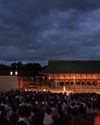Invitation Of Noh:Kyoto Takigi Noh

This is the first installment of special series of fresh viewpoints on Noh, INVITATION TO NOH, in the year of KJ’s 30th anniversary.
The archetypal Japanese performance art now known as Noh theater (Nohgaku) was established by Zeami and his father Kan’ami in the 15th century, based on an earlier form known as Sarugaku. It includes three kinds of traditional plays, Noh, Kyogen and Shikisanban, which inherits the sacred ritual form of the original Sarugaku style. Kyogen is a sophisticated comic play developed from Sarugaku, traditionally performed between Noh plays. Noh was designated in 1957 as Japan’s first important Intangible Cultural Property, and was proclaimed in 2001 by UNESCO as an Intangible Cultural Heritage of Humanity.
Originally, Noh was mostly performed outdoors. Noh butai (stages) were built in places such as the precincts of temples or shrines and were open to the four directions. Illumination was provided naturally by sunlight and was also reflected by white sand spread around the stage. Since the Meiji Period, from the 1860s, Nohgaku-do or theater style has become popular, with audiences enjoying the Noh stage from indoor seats. The roof seen over the stage, below the theater’s ceiling, is a relic of the former style. Technically, Noh can be performed anywhere with a square space for a stage, connected by a hashigakari (bridge) with the backstage space from which the Noh actors come and go.
This story is from the Issue 86 edition of Kyoto Journal.
Start your 7-day Magzter GOLD free trial to access thousands of curated premium stories, and 8,500+ magazines and newspapers.
Already a subscriber ? Sign In
This story is from the Issue 86 edition of Kyoto Journal.
Start your 7-day Magzter GOLD free trial to access thousands of curated premium stories, and 8,500+ magazines and newspapers.
Already a subscriber? Sign In

Checking Out - The Final Days Of Hotel Okura
Checking Out - The Final Days Of Hotel Okura

Invitation Of Noh:Kyoto Takigi Noh
Invitation Of Noh:Kyoto Takigi Noh

Finding The Sky
Finding The Sky

Maid To Love
Maid To Love

Upholding Lightness
Interview with Francesca Lanzavecchia and Hunn Wai of Lanzavecchia + Wai.

The Art of Island Time
The Art of Island Time

Choose Your Own Adventure
Choose Your Own Adventure

The Great Gold
An interview with Gary Snyder at Sakura time.

Unbridled Perception
The founders of the Miksang Institute for Contemplative Photography bring their practice to Asia with a pioneering workshop in Japan.